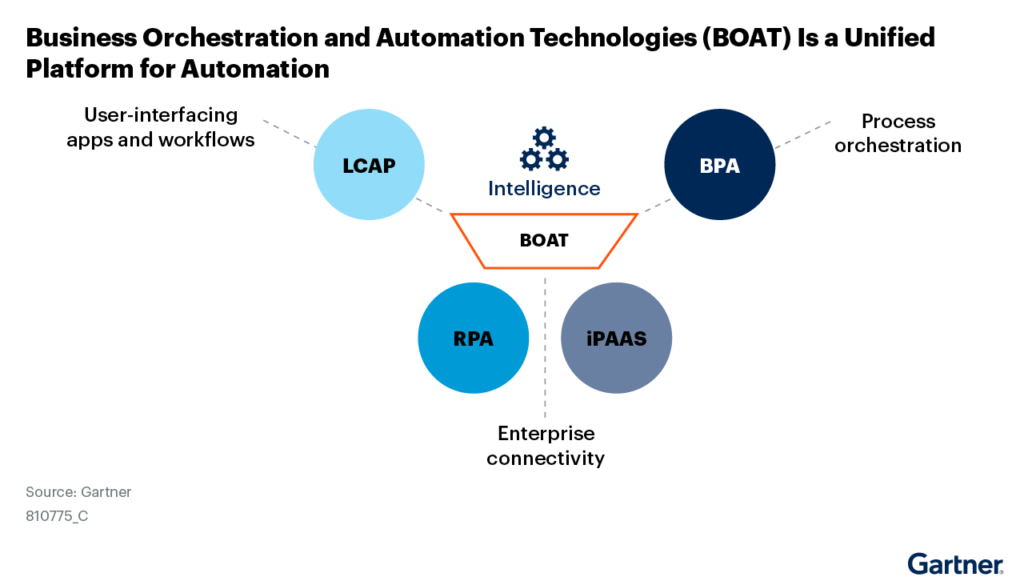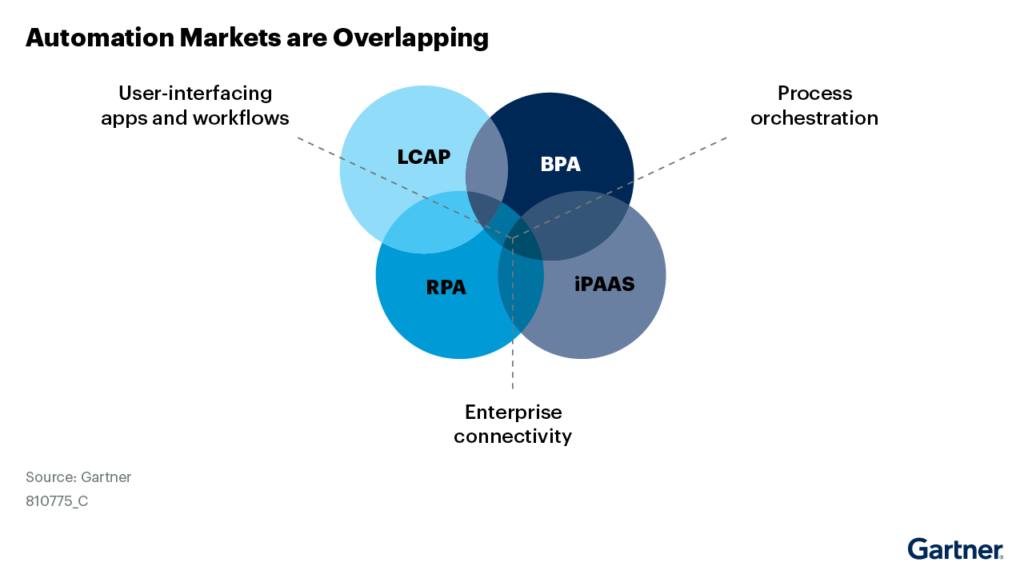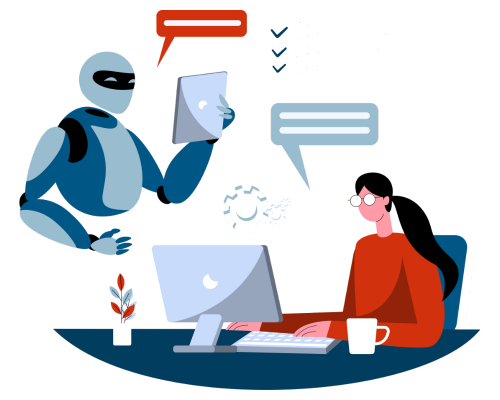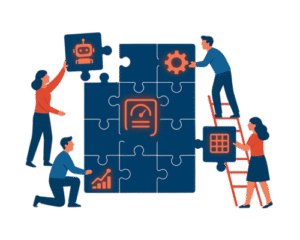Gartner’s latest research underscores the rapid evolution of automation technologies, with a particular emphasis on the convergence of robotic process automation (RPA), business process automation (BPA), and low-code application platforms (LCAP). The overlap of these technologies has posed challenges for enterprise application leaders in selecting the right vendors and solutions. Gartner refers to this emerging class of technology as BOAT—a comprehensive platform that consolidates the capabilities of RPA, BPA, and other automation tools into a single, unified solution.
In this blog, we’ll explore Gartner’s insights on this new technology and examine how BOAT is poised to transform the automation landscape.
What are Business Orchestration and Automation Technologies (BOAT)?
Business Orchestration and Automation Technologies (a.k.a BOAT) represent the next generation of automation tools that combine the capabilities of various existing technologies like Robotic Process Automation (RPA), Business Process Automation (BPA), and Low-Code Application Platforms (LCAP). BOAT platforms integrate these technologies into a single, unified solution, providing businesses with a powerful toolset to automate and optimize their processes from end to end.

The Current Automation Landscape
Before diving deeper into BOAT, it’s essential to understand the current automation landscape and the key technologies that have paved the way for this innovation.
1. Robotic Process Automation (RPA)
Robotic Process Automation (RPA) is a technology that automates repetitive and mundane tasks typically performed by humans. These tasks can include data entry, invoice processing, and other routine activities. RPA bots mimic human actions and interact with digital systems to execute these tasks quickly and accurately.
2. Business Process Automation (BPA)
BPA takes automation a step further by focusing on entire business processes rather than individual tasks. BPA aims to streamline and optimize workflows, ensuring that processes run smoothly and efficiently. It involves automating end-to-end processes such as order fulfillment, customer service, and supply chain management.
3. Low-Code Application Platforms (LCAP)
LCAPs enable non-technical users to create applications with minimal coding. These platforms provide a visual interface and pre-built components, making it easier for business users to develop and deploy applications quickly. LCAPs are particularly useful for creating custom solutions to address specific business needs without relying heavily on IT departments.
The Challenges with Current Technologies
While RPA, BPA, and LCAP have revolutionized business automation, they often overlap in their capabilities. This overlap can lead to confusion for businesses when selecting the right vendor or solution.

The Need for Consolidation
The rapid overlap of different automation technologies is prompting enterprise application leaders to search for a platform that can cater to the end-to-end needs of a wide range of automation use cases. This need for consolidation is driving the market toward a natural merger of these technologies, leading to the emergence of BOAT.
Key Capabilities of Business Orchestration and Automation Technologies (BOAT)
End-to-End Business Process Orchestration
One of the key capabilities of Business Orchestration and Automation Technologies (BOAT) platforms is their ability to orchestrate complex business processes across different systems and departments. This involves managing workflows that span multiple applications and services, ensuring seamless coordination and execution. BOAT platforms provide a centralized control mechanism that can handle the intricate dependencies and interactions between various process components. By orchestrating these processes, BOAT platforms help organizations achieve higher levels of efficiency and accuracy, reduce manual interventions, and ensure compliance with business rules and regulations.
For instance, in a typical procurement process, a BOAT platform can orchestrate the workflow from requisition to payment. It can integrate with the organization’s ERP system to check inventory levels, initiate purchase orders, manage approvals, and process payments, all while ensuring that each step is executed in the correct sequence and according to predefined rules. This orchestration not only speeds up the process but also reduces the risk of errors and delays.
Enterprise Connectivity
A critical feature of BOAT platforms is their ability to integrate with a wide array of enterprise systems. This includes legacy systems, cloud-based applications, and other digital platforms, enabling organizations to connect disparate systems and create a unified automation ecosystem. Integration is essential for ensuring that data flows seamlessly between different systems and that processes can be automated end-to-end without manual intervention.
BOAT platforms use APIs and other integration mechanisms to connect with various enterprise systems. For example, they can integrate with CRM systems to automate customer interactions, with ERP systems to streamline financial processes, and with HR systems to manage employee workflows. This integration capability allows organizations to leverage their existing IT investments while enhancing their automation capabilities.
Embedding AI and Generative AI Technologies
BOAT platforms leverage AI and generative AI to enhance automation capabilities. This includes intelligent document processing, process mining, and autonomous decision-making. Generative AI further enables the creation and optimization of workflows based on business goals and data-driven insights. By embedding AI technologies, BOAT platforms can analyze data, identify patterns, and make intelligent decisions that optimize processes and improve outcomes.
For instance, in document processing, AI can be used to extract information from unstructured documents, classify documents, and route them to the appropriate workflows. In process mining, AI can analyze process logs to identify bottlenecks and inefficiencies, providing insights that can be used to optimize workflows. Generative AI can be used to design new workflows based on historical data and business objectives, ensuring that processes are continuously improved and adapted to changing conditions.
The Autonomous Future of Automation
One of the key enablers for the emergence of BOAT platforms is the advancement of specialized and generative AI technologies. These technologies enhance the capabilities of automation tools by adding intelligence, autonomy, and adaptability to the process execution and management.
Complex Task Automation
AI technologies enable the automation of tasks that traditionally required human judgment. This includes document understanding, sentiment analysis, fraud detection, and decision-making based on complex criteria. AI can process large volumes of data quickly and accurately, making it ideal for tasks that involve data analysis and pattern recognition.
For example, in the financial services industry, AI can be used to detect fraudulent transactions by analyzing transaction data and identifying patterns that indicate fraud. In customer service, AI can be used to understand and respond to customer inquiries, providing accurate and timely information. By automating these complex tasks, organizations can improve efficiency, reduce costs, and enhance the quality of their services.
Process Optimization
AI can learn from data, feedback, and outcomes to continuously optimize processes. By analyzing patterns and trends, AI can adjust process logic and parameters to improve efficiency and effectiveness. This capability is particularly valuable in dynamic environments where processes need to be continuously adapted to changing conditions.
For instance, in manufacturing, AI can be used to optimize production processes by analyzing data from sensors and other sources. It can identify inefficiencies, predict maintenance needs, and adjust production schedules to minimize downtime and maximize output. In logistics, AI can optimize delivery routes and schedules, ensuring that goods are delivered on time and at the lowest cost.
Intelligent Agents
Generative AI powers the creation of intelligent agents that can perform a series of end-to-end tasks. These agents are conversational and context-aware, capable of responding to events and orchestrating actions autonomously. Intelligent agents can interact with users and systems, gather information, make decisions, and execute tasks without human intervention.
For example, in customer service, intelligent agents can handle inquiries, resolve issues, and provide personalized recommendations. In HR, they can manage employee onboarding, answer questions, and schedule interviews. By automating these interactions, intelligent agents can improve the efficiency and quality of services, reduce the workload on human employees, and enhance the user experience.
Benefits of Business Orchestration and Automation Technologies
The adoption of BOAT platforms offers numerous benefits for businesses of all sizes and industries. Let’s explore some of the most significant advantages:
1. Enhanced Efficiency
By integrating multiple automation technologies, BOAT platforms streamline business processes and reduce redundancy. This integration leads to faster execution of tasks, fewer errors, and improved overall efficiency.
2. Improved Decision-Making
With enterprise connectivity and AI-powered insights, BOAT platforms enable better decision-making. Businesses can access real-time data, analyze trends, and make informed decisions to drive growth and innovation.
3. Greater Flexibility
BOAT platforms support the creation of new processes and the optimization of existing ones, catering to various business needs. This flexibility allows organizations to adapt to changing market conditions and customer demands quickly.
4. Cost Savings
Automation reduces the need for manual labor, leading to significant cost savings. By automating repetitive tasks and optimizing processes, businesses can allocate resources more efficiently and focus on higher-value activities.
5. Scalability
BOAT platforms are designed to scale with the organization’s growth. Whether a business is small or large, these platforms can handle increasing volumes of data and processes, ensuring that automation remains effective and efficient.
A New Class of Technology
As businesses recognize the value of BOAT platforms, a new market is emerging for these technologies. BOAT platforms encompass a common set of capabilities from RPA, BPA, and iPaaS, along with additional technologies like intelligent document processing and process mining.
Key Features of BOAT Platforms
- Long-Running Workflows with Complex Rules: BOAT platforms can handle workflows that require intricate rules and conditions, such as case management.
- Autonomous and Intelligent Orchestration: Powered by generative AI agents, BOAT platforms can autonomously orchestrate tasks and processes.
- Routine Task Automation: BOAT platforms automate routine and repetitive tasks, freeing up human resources for more strategic activities.
- Intelligent Ingestion of Unstructured Data: These platforms can intelligently process and analyze unstructured data, such as documents and emails, to extract valuable insights.
Key Takeaways
Emergence of BOAT
A new market is forming, characterized by platforms that enable end-to-end business process orchestration and automation. BOAT platforms represent a significant evolution in the automation landscape, offering a comprehensive set of capabilities that address the complexities of modern business environments.
Market Consolidation
The consolidation of automation capabilities is driving the market toward unified platforms that cater to a wide range of automation use cases. This trend is reshaping the vendor landscape and leading to the emergence of new and innovative solutions that provide more value to customers.
Autonomous Future
The advancement of AI and generative AI technologies is propelling automation towards a future where processes are not only automated but also intelligent and adaptive. This vision of autonomous automation is becoming a reality as AI technologies are integrated into BOAT platforms, enabling more intelligent and effective automation solutions.
RPATech Expert Opinion
“At RPATech, we believe the future of automation lies in seamlessly integrating bots with humans and across various platforms. By combining modern technologies like generative AI and other AI tech with Robotic Process Automation (RPA), organizations can develop intelligent, effective automation solutions. These advanced systems streamline processes and deliver lasting value, significantly enhancing productivity and efficiency across the enterprise.” Alok Mani Tripathi, CEO & Founder at RPATech.
Conclusion
Business Orchestration and Automation Technologies (BOAT) represent a significant leap forward in the world of automation. By consolidating the capabilities of RPA, BPA, and LCAP, and integrating advanced AI, BOAT platforms offer a powerful solution for businesses seeking to streamline operations and stay ahead in a competitive market. With their ability to orchestrate end-to-end processes, provide real-time insights, and adapt to changing needs, BOAT platforms are poised to become an essential component of the modern business toolkit.
If you’re ready to take your automation initiatives to the next level and discover how they can transform your business processes. Book a consultation with our automation experts today and learn how you can leverage the power of automation to drive efficiency and innovation.




